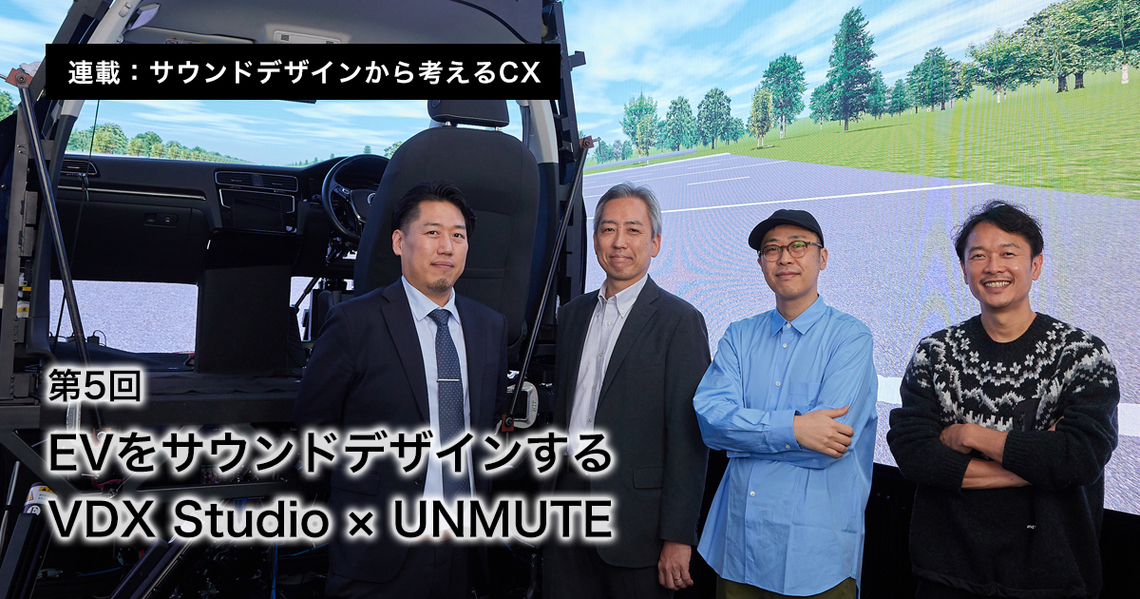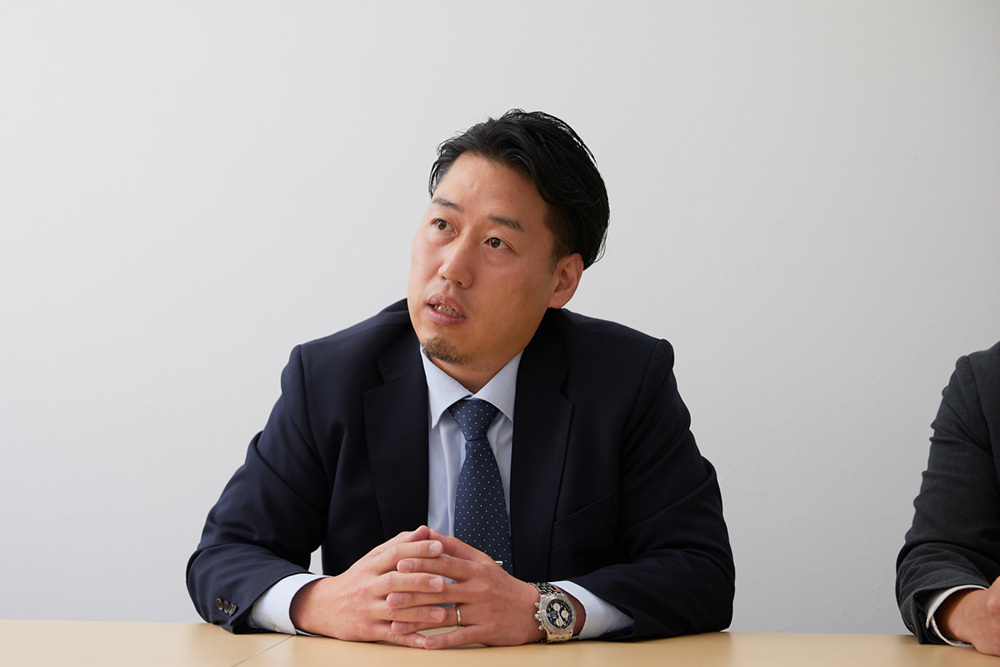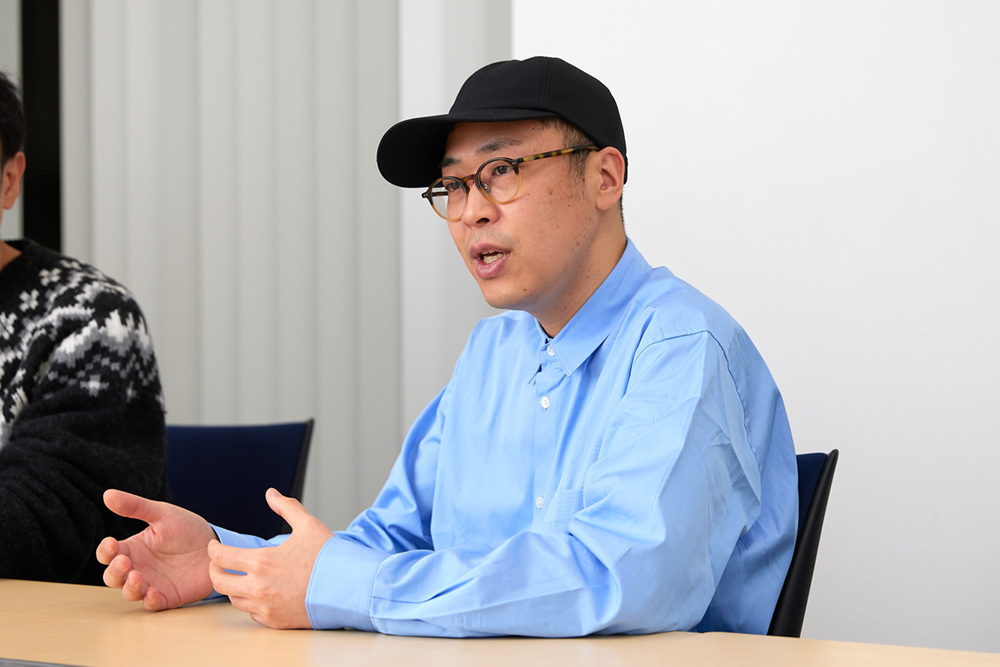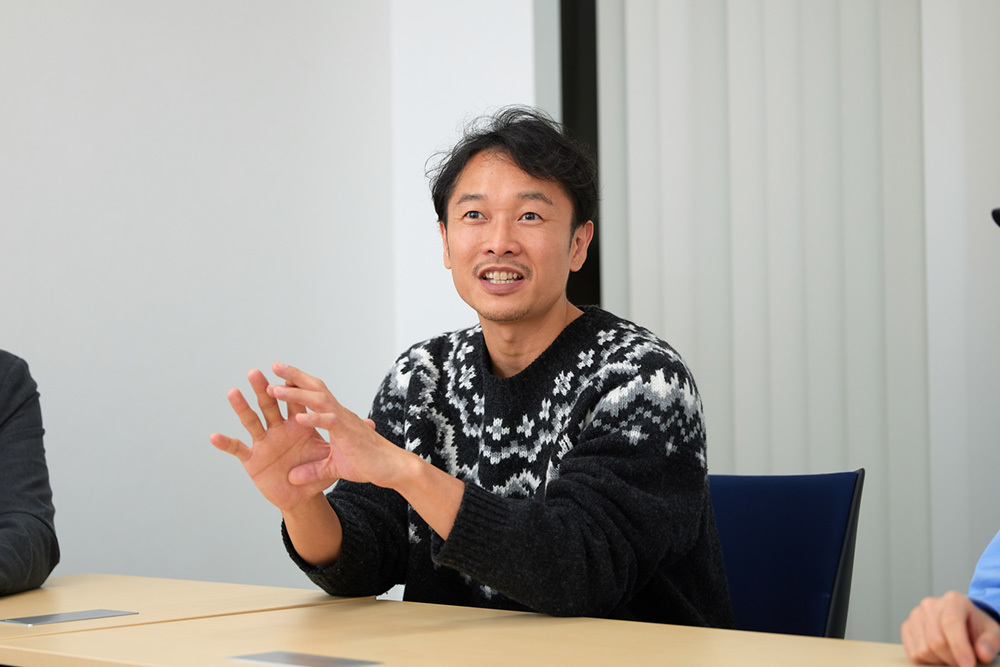What should the driving sound of EVs (electric vehicles), replacing engine noise, be like?
How do different EV driving sounds affect driver behavior?
Dentsu International Information Services (ISID)*, which plans and operates the driving simulator facility "VDX Studio (Virtual Driving eXperience
Studio), and Estech Corp. (Dentsu Inc.), along with Dentsu Lab Tokyo/STARRYWORKS, which provides the specialized sound design solution "UNMUTE," have launched a joint project to tackle EV sound design ahead of the widespread adoption of EVs.
*Effective January 1, 2024, ISID changed its company name to DENTSU SOKEN INC.
We spoke with the four core project members—Daisuke Tomoyasu (ISID), Nobuyuki Himeno (ESTECH), Yasuhiro Tsuchiya (Dentsu Lab Tokyo), and Koji Kimura (STARRYWORKS)—at VDX Studio in Kanazawa Ward, Yokohama, about their current activities and future outlook.
VDX Studio Facility Overview

From left: Nobuyuki Himeno (ESTECH), who plans and operates VDX Studio, and Daisuke Tomoyasu (ISID); Yasuhiro Tsuchiya (Dentsu Lab Tokyo) and Koji Kimura (STARRYWORKS), who provide "UNMUTE," a solution specializing in sound design.
(The roundtable discussion was held on November 16)
Moving Beyond "Low Noise"
──First, what challenges and circumstances led to the start of this collaborative project tackling EV sound design?
Himeno: For a long time, automotive development focused on "noise reduction"—how to make vehicles quieter. However, with the advent of EVs and the absence of engine noise, new challenges emerged. We now need to address not just eliminating sounds, but actively designing sounds to create a comfortable cabin environment. This involves eliminating other sounds that become noticeable without the engine noise, or even adding simulated engine sounds to enhance the driving experience. This is essentially the challenge of "sound enhancement."
However, there are limitations to verifying this sound design using actual vehicles. For example, it's quite difficult to perform simulations using real cars where you can freely control the levels of road noise or wind noise during driving and then see what happens when you add sounds to that environment.
Tomoyasu: Sound evaluation using computer simulations has been done for some time. However, evaluating based solely on the sounds heard through the ears is actually insufficient. Especially for evaluating sounds related to vehicles, the assessment must include the physical sensations transmitted through vibration, the sense of speed conveyed visually, and other such combined stimuli.
This is where evaluation in virtual environments like VDX Studio becomes crucial. Not just any driving simulator will suffice for a virtual environment; it requires high-level realism. VDX Studio is designed with immersive displays, vibration systems, and meticulous sound reproduction, aiming to create a verification environment as close to the actual vehicle as possible.

Daisuke Tomoyasu, General Manager, Advanced CAE Technology Department, Manufacturing Solutions Division, Dentsu Inc. (International Systems Information Development)
Since joining the company, he has supported product development in manufacturing as an engineer evaluating "object motion" using mechanism analysis. He has also been involved in developing evaluation environments for "human motion" and participated in joint research on driving simulators with automotive manufacturers. Currently, he is promoting solution development using compact driving simulators as "proprietary verification technology combining real and virtual elements."
Tsuchiya: Back when ISID and ESTECH were developing VDX Studio, an interview article featuring artist Suzuki Yuri and myself was published in Web Dentsu Inc . Tsūhō. In that article, we were discussing precisely how EV sound design should be approached. After reading it, Tomoyasu reached out to me, asking, "Is there something we could collaborate on?"
Actually, around the time he reached out, we were preparing to launch "UNMUTE," a solution specialized in sound design, with Dentsu Lab Tokyo and STARRYWORKS. So, first, we visited VDX Studio with Mr. Kimura. We experienced a demo, received an explanation of the system, and shared detailed actual data. We then discussed what kind of mechanism we could build on our side to generate driving sounds in real-time, linked with VDX Studio's simulator.
Kimura: On the STARRYWORKS side, we developed a program that bridges the simulation data received from VDX Studio to the program designed by Tsuchiya-san to generate the sounds. We connected our developed program to VDX Studio and confirmed it worked perfectly. During development, we were testing sounds on our desktops, but hearing the sounds play while actually operating the car in VDX Studio was a surprisingly fresh experience. Beyond just driving sounds, we feel tremendous potential in being able to conduct various experiments related to EV sound design in a place like VDX Studio.
──You all come from different companies. How do you see your respective areas of expertise and roles within the project?
Tsuchiya: I handle the foundational ideas for sound-based experience design. This includes determining the intent behind generating engine sounds, deciding which driver and vehicle data to use, and currently, the specific sound design aspects. Mr. Kimura takes care of the system implementation side.
Kimura: As Tsuchiya mentioned, I primarily handle creating the interaction mechanisms and UI design—areas where STARRYWORKS excels—while also collaborating on brainstorming ideas.
Himeno: At ESTECH, I've provided technical support to clients in areas like sound, vibration, and vehicle dynamics. Many of these clients are sound development engineers at automotive manufacturers. Within this project team, I'm the one closest to the client perspective. My role involves consulting with clients on sound-related matters, addressing both noise reduction and sound design aspects through ongoing dialogue.

Nobuyuki Himeno, Estech Corp. Technical Experiment Department, Project Manager
Previously, as an engineer at an automotive manufacturer, he was involved in performance development for vibration and noise, handling stability, and ride comfort.
After joining Estech Corp., he has dedicated himself to technical consulting for various mechanical products, primarily focused on automobiles. He is currently advancing a mission to design human sensory performance in dynamic performance using tools like driving simulators.
Tomoyasu: At ISID, we believe it's crucial to fully leverage ESTECH's strengths as a group company and integrate them into ISID's solutions for our customers.
Even with driving simulators, ISID's expertise alone is somewhat limited in meeting diverse customer needs. Combining ESTECH's real-vehicle measurement technology with ISID's analytical modeling technology significantly enhances realism. Furthermore, ISID has numerous sales members engaged with various industries, including the automotive sector. ISID's role in this project is to accurately grasp customer challenges and plan, develop, and deliver solutions.
Furthermore, by having Dentsu Lab Tokyo and STARRYWORKS join the project this time, we believe we can now offer more creative sound proposals in addition to the traditional engineering perspective.
Can sound design actually change driver behavior?
──Could you briefly explain the overview and features of VDX Studio again?
Tomoyasu: Driving simulators come in various sizes, from large to small. The VDX Studio driving simulator falls into the smaller category. However, we are meticulous about the reproduction quality of the three elements perceived by the driver seated in the cockpit: "sound," "vibration," and "visuals." It can be said to be at a very high level.
We also rent out the VDX Studio driving simulator to customers. A major difference from previous driving simulators is that we operate it not just for our own use, but as a facility to solve our customers' challenges.
Himeno: To improve the acoustic environment, the walls of VDX Studio are lined with a material called "glass wool." This material absorbs sound, so while it doesn't achieve a completely "anechoic" space, it creates a "simplified anechoic" environment.
Additionally, to improve sound reproduction, we've implemented our proprietary spatial audio system. By measuring the acoustic transmission characteristics from all 16 channels—15 speakers and 1 subwoofer—to the ear position, and then correcting the sound through this system, we can reproduce highly realistic audio at the driver's ear position.

Overview of VDX Studio. When a driver in the driving simulator (back) presses the accelerator, the data is sent to the computer (front). The program generates driving sounds and uses all 16 channels from 15 speakers and 1 subwoofer to reproduce realistic sound at the driver's ear position.
──Prior to this roundtable, we were shown a demonstration of the driving simulator. Could you explain again what this allows us to verify?
Tsuchiya: What we demonstrated earlier was driving sound designed experimentally in the early stages of this project. This sound was created as the sound inside the car—that is, the sound heard by the driver. The program acquires numerical values from the simulator, such as the amount of accelerator pedal depression and the resulting change in motor RPM, and generates sound synchronized with these inputs.
The demonstration you saw earlier simulated a range of sounds, from standard driving sounds to four distinct concept sounds.
● Standard driving sound
Simulates the actual sound of an EV in motion. Since it uses a motor instead of an engine, the sound is very quiet.
●Driving Sound 1
Simulates the mechanism of engine sounds based on accelerator opening and RPM, while creating combinations of harmonics structurally impossible in a real engine to produce a sound that evokes a sense of floating.
●Driving Sound 2
A driving sound designed to resonate musically. As RPM increases, it resonates like a string ensemble.
●Driving Sound 3
A sound simulating a powerful racing car engine.
●Driving Sound 4
When you press the accelerator, the music evolves in response to your speed.
Tsuchiya: What I found fascinating when actually playing back the pre-designed sounds in VDX Studio's simulation environment was how subtle changes in sound linked to driving controls—like the accelerator, brakes, and handling—create a sense of self-attribution, or what you might call a feeling of unity between driver and car. Just the slightest change in sound linked to minor inputs creates a tangible sense that you are truly controlling the vehicle. When you press the accelerator, you feel the sound of the engine's revs increasing throughout your entire body. I believe engine sounds inherently serve to reinforce this sense of self-attribution.
Testing multiple driving sound types revealed something interesting: when accelerating triggers a musical progression or when designing sounds with large changes, drivers tend to speed up more than with other driving sounds. They start driving in a way that involves aggressively pressing the accelerator and brakes to enjoy the changes.
This suggests that the approach to engine sound design could potentially influence driver behavior. For example, if we could design sounds that become muffled during specific dangerous maneuvers or grow louder when exceeding the legal speed limit, we might create a UX that encourages drivers to follow the rules.
Currently, we're at the stage where the environment is set up, and we're making various discoveries through experimentation. Looking ahead, we envision creating original sounds tailored to customer needs, developing them iteratively through experimentation.

Yasuhiro Tsuchiya, zero/Dentsu Lab Tokyo Creative Technologist/Researcher. After working at an advertising production company, joined Dentsu Inc. in 2006. Assigned to the CX Creative Center since 2021. Engaged in research and development of products centered on fields like biosignals and robotics, aiming to develop and implement "slightly futuristic communication" utilizing technology.
Like the face of a smartwatch
──Finally, could you share your outlook for the project's future?
Tomoyasu: First, we really want people conceptualizing car designs to use VDX Studio. When trying to create something unprecedented, building actual prototype vehicles for verification can be quite challenging. VDX Studio offers high-level reproducibility, so we believe it can serve as a valuable platform for concept validation and accumulating simulation data.
Kimura: Personally, I think of it this way: while a mechanical watch is a fully realized piece of hardware, a smartwatch allows extensive customization, from the band to the watch face design. A high-end sports car is, in a sense, like a super-luxury mechanical watch—a pure luxury item focused on the hardware and its design, fulfilling the joy of ownership and the pleasure of use. That's wonderful in its own right.
On the other hand, as EVs become more common and autonomous driving advances, I think people's attachment to cars and their perspective on car travel might change. Just as some people set their smartwatch faces to character designs while others prefer cool patterns, we might also customize the sounds within the car. For instance, when Dad is driving alone, he could choose a dynamic driving sound that lets him feel the thrill of acceleration. When Mom is driving, a different sound might play. And when the family is together, they could select relatively quiet driving sounds or UI sounds that don't interrupt conversation, allowing everyone to chat comfortably.

Koji Kimura, CEO of STARRYWORKS. Born in Osaka Prefecture in 1981. Founded STARRYWORKS in 2006, creating content that fuses design and technology across various fields including entertainment, advertising, and product development. Established subsidiary YAMI Inc. in 2015, specializing in horror content; BUTTON Inc. in 2016, focused on parent-child communication; and food service company HU Inc. in 2021. Appointed as a Specially Appointed Professor at Osaka University of Arts in 2018.
Tsuchiya: That's fascinating. Much like the "customization" features for various devices, in the not-too-distant future, we might see a marketplace-like system where you can download your favorite sound assets designed by creators and install them in your car.
Kimura: Looking ahead, I believe not only sounds but also interiors and panels will all become screens. I sense a future where design themes from high-end fashion brands might appear on such marketplaces.
Himeno: On the other hand, from the automaker's perspective, the shift to EVs and the loss of engine sound could be seen as losing part of their identity. Therefore, when developing EVs, I think they'll consider expressing their brand's new identity through the EV's driving sound. In that sense, I believe EV sound design will evolve from both the user's and the automaker's perspectives.
Tomoyasu: That's right. What exactly is the "sound of the brand"? To determine that, we need to conduct numerous tests. VDX Studio is highly effective for this testing. Car sounds aren't experienced in isolation; they're part of the overall experience of various sounds and vibrations produced when the car is actually driven. Therefore, being able to run more trials at a lower cost than testing with actual vehicles is crucial.
Tsuchiya: Personally, I see tremendous potential in linking driving sounds with the driver's biometric data, like heart rate. Just as a car sounding off indicates engine trouble, if driving sounds linked to biometrics sound unusual, it could prompt the driver to think, "Hmm, maybe I'm not feeling well today?" This would fundamentally change the relationship between people and cars. By viewing the car as a single interactive system that includes the driver, I believe sound opens up possibilities for various designs.
Himeno: Actually, we can already capture the driver's biometric data like heart rate, brain waves, pupil diameter, and hand perspiration. Using this data to evaluate sounds or train AI could potentially generate the desired sound for each moment. Furthermore, we want to delve deeper into whether the driver is currently focused on driving or becoming distracted.
Kimura: From the perspective of "detecting danger," I believe sounds from outside the vehicle also hold potential. By collecting ambient sounds from all directions with microphones, we could selectively allow certain external sounds to be heard inside the car, even with the windows closed, depending on the situation. For example, if we could play the sound of a car or bicycle approaching from behind—something not visible in the rearview—through the rear speakers inside the car, it could help prevent accidents by making the driver aware of the rear. I believe sound can intuitively convey situations that the car knows about but are difficult for humans to detect.
Tsuchiya: As we've heard several ideas from everyone today, I believe EV sound design holds tremendous potential. Achieving this will require collaboration among various companies—automakers, auto parts manufacturers, car navigation system makers, car audio manufacturers, and more. We sincerely hope to contribute our expertise and join in designing the new driving experiences of the future.














